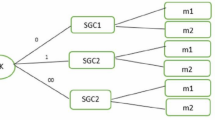Abstract
Over the last century, Wireless Sensor Network (WSN) has given major advances in several distinguishable fields. In addition, it has also evolved many features such as high device heterogeneity, high scale and supporting multiple applications. In WSN, Key management is employed (involves) as a significant component of network security, especially in multi-cast based applications and services. Group key management has a vital role in multi-cast secure communication with huge number of group members. Group key must always be updated dynamically to all groups in the network and keys to be redistributed currently to active members only. Consequently, a secret key called session key for a group of members is stored in key trees that are shared efficiently between them, in order to achieve secure group communication. The key trees are used to encrypt with other keys and data are transmitted to ensure security. Logical key hierarchy (LKH) is a hierarchical structure of multiple keys to provide a scalable and secrecy for group communication. This research work proposes a new hierarchical group key management (HGKM) using multiple logical key trees for dynamic groups in order to enhance the Quality of Service of the network. Among the multiple logical trees, primary tree can be selected by tree selection algorithm. In WSN, there are high numbers of members joining or leaving the group at any time, resulting with rekeying process becoming too large. This leads to degraded efficiency of tree-based key management system. Further, communication overhead of rekeying process can be mitigated by one-way key derivation method which integrates with multiple logical key trees. In this method, tree server does not need to be encrypted. Rather, it involves in sending a new key to members who are capable of derive their own keys in same way the server does. This results with a need for less number of encrypted keys for each rekeying process within the group tree. The fixed interval time is called batch time, which is applied in each rekeying process after nodes join or leave the group. The proposed approach can improve the bandwidth utilization effectively. The proposed HGKM method is implemented in Network Simulator (NS-2) environment and obtained results are compared with existing two methods such as LKH and multiple logical tree key management (MLT-KM). QOS of proposed approach is evaluated in terms of Bandwidth Efficiency.







Similar content being viewed by others
Change history
04 July 2022
This article has been retracted. Please see the Retraction Notice for more detail: https://doi.org/10.1007/s12652-022-04264-3
References
AlFarraj O, AlZubi A, Tolba A (2018) Trust-based neighbor selection using activation function for secure routing in wireless sensor networks. J Ambient Intell Hum Comput, pp 1–11
Antony D, Raj A, Sumathi P (2017) A review on security issues in wireless sensor networks using bio-inspired computing. Imperial J Interdiscip Res (IJIR) 3(3):1457–2461
Chen C-M, Wang K-H, Yeh K-H, Xiang B, Wu T-Y (2019) Attacks and solutions on a three-party password-based authenticated key exchange protocol for wireless communications. J Ambient Intell Hum Comput 10:3133–3142
Darwish A, Hassanien AE, Elhoseny M, Sangaiah AK, Muhammad K (2019) The impact of the hybrid platform of internet of things and cloud computing on healthcare systems: opportunities, challenges, and open problems. J Ambient Intell Hum Comput 10:4151–4166
Deepika, Manpreet (2016) A review on various key management techniques for security enhancement in WSN. Int J En Trends Technol (IJETT) 34(4):154–158
Elqusy AS, Essa ES, El-Sayed A (2017) Key management techniques in wireless sensor networks. Commun Appl Electron (CAE) 7(2):8–18
Guan J, Liu X, Yao S, Jiang Z (2018) Design and implementation of a central-controllable and secure multicast system based on universal identifier network. Sensors 18(7):2135
Idrees KS, Chow C-O, Ishii H, Tanveer Zia A (2013) Threat models and security issues in wireless sensor networks. Int J Comput Theory Eng. https://doi.org/10.7763/ijcte.2013.v5.806
Laouid A, Dahmani A, Hassen HR, Bounceur A, Euler R, Lalem F et al (2019) A self-managing volatile key scheme for wireless sensor networks. J Ambient Intell Hum Comput 10:3349–3364
Mahaveerakannan R, GnanaDhas CS, Rama Devi R (2018) Multicast hybrid group key management in wireless networks environment. EAI Endorsed Trans Energy Web Inf Technol 5(20):1–6
Parikh S, Patel A, Rizvi S (2014) Increasing quality of service (QoS) in wireless sensor networks (WSN) by using timestamp optimization scheme. In: IEEE, pp 3–5
Tsitsipis D, Tzes A, Koubias S (2017) CHAT: Clustered hierarchical key management for wireless sensor networks using network topology. Int J Distrib Sens Netw. https://doi.org/10.1177/1550147717741570
Xiong N, Wu Z, Huang Y, Xu D (2014) Analyzing comprehensive QoS with security constraints for services composition applications in wireless sensor networks. IEEE 14(12):22706–22736
Zhang Y, Wu C, Cao j, Li X (2013) A secret sharing-based key management in hierarchical wireless sensor network, IEEE. In: 4th International Conference on software engineering and service sciences, pp 2327-0586, https://doi.org/10.1155/2013/406061
Zou Z, Qian Y (2019) Wireless sensor network routing method based on improved ant colony algorithm. J Ambient Intell Hum Comput 10:991–998
Author information
Authors and Affiliations
Corresponding author
Additional information
Publisher's Note
Springer Nature remains neutral with regard to jurisdictional claims in published maps and institutional affiliations.
This article has been retracted. Please see the retraction notice for more detail: https://doi.org/10.1007/s12652-022-04264-3
About this article
Cite this article
Pon Senniah, J., Ram Prasad, A.V. RETRACTED ARTICLE: Efficient data sensing with group key management for intelligent automation system by one-way key derivation in wireless networks. J Ambient Intell Human Comput 12, 4655–4662 (2021). https://doi.org/10.1007/s12652-020-01862-x
Received:
Accepted:
Published:
Issue Date:
DOI: https://doi.org/10.1007/s12652-020-01862-x




